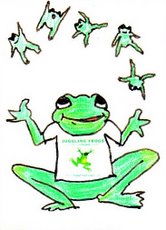My GTD capture tools and indexing system
According to the Getting Things Done by Dave Allen methodology, when information enters your life via other people, your own thoughts, or divine inspiration, you need a way to get it out of your head, capture it, and place it in a trusted system for later processing.
This is accomplished by using a "Ubiquitous Capture Tool". This can be as complicated as an elaborately synchronized computer-to-pda system, or as simple as a pen and paper. The idea is to quickly capture anything that pops into your head, no matter where you are and no matter what you are doing.
I use a hybrid system, combining a bound notebook with a computer and pda.
The notebook is my main capture tool. When I process the information from the notebook, it goes either into my planner software (addresses and appointments, data in lists), or gets indexed for reference (conversations, meetings, and ideas.)
I keep the first pages of the notebook as a table of contents. When I'm waiting in the carpool lane, in a doctor's waiting room, or on hold, I enter pointers to the significant notes of the past few days in this list. (An entry looks like: "page 55 10/17/08 Dr. XXXXX for Abigail, Hannah, and Jonathan" or "page 33B 10/10/07 XXXXX committee meeting".)
Every month or so, when I use up a notebook, I label it with its date range, make a copy of the table of contents, and store it on a shelf near my desk. The copy of the table of contents goes into the Master Index. I use the start month and year ("8/07") as the name that identifies that particular notebook.
I have two indexes: The Master Index and the Idea Index.
The Master Index helps me find conversation and meeting notes, and it holds the table of contents pages from all the books. This saves me from having to open 10 books to find the notes from a specific interaction.
The Master Index has a page for each of the regular meetings I attend, and for people with whom I have frequent conversations that result in note-taking. On those pages, I list the notebook and page where the notes can be found.
Often, I only bother to record something on these pages after I had to look it up. For example, I keep a running list of questions to ask our school principal. Let's say these are on page 44 of a book. When I finally get a chance to ask them, I'll take notes, lets say on page 111.
Three months (and two books), for some reason I need to look up something from that conversation. I grab the Master Index, to see which book they're in using the copies of the tables of contents, and grab the appropriate book to read the actual notes.
At this time, I'll turn to the Principal's page in the Master Index, and write down the book's start date and the page numbers there ("8/07 list of questions p.44, answers p.111"). This way, I'm not obsessively cross-referencing information, but I'm not searching for things twice, either.
My Idea Index is a manifestation of what canonical GTD calls the "Someday, Maybe" list in the form of a Rolodex 3"x5" card file. It helps me keep track of seasonal plans and projects that I'd like to do, but haven't committed to implementing. It's a cross between a tickler file and an index.
If I spend an afternoon doodling in my notebook, planning next year's back to school projects, when it comes time to process this information, I scribble the notebook and page number on a 3"x5" card and stick it in the Idea Index, filed under "back to school".
Near the beginning of next school year, I'll thumb through all the cards in the "back to school" section of the Idea Index. If I choose to implement one of the projects, I'll have the reference to the plans listed on its card. If not, those references and plans can wait until the following year.
Thus, I use the bound notebook as both a Ubiquitous Capture Device and a reference file.
Sometimes, however, the idea I want to put in the Idea Index is just a simple one-liner, such as "post edible cornucopia tutorial on blog" for Thanksgiving. I don't want to make a task/to-do/"next action" about this. If I put every idea in my task list, I'd never see the stuff I have committed to do for all the clutter.
Employing what I call the "Meta Two Minute Rule", I write the note quickly on a card, and stick it in the Idea Index. This is why I like to keep Rolodex-compatible 3"x5" cards available all around the house, and in my car. They let me bypass the notebook when appropriate.
See also:







5 comments, so far. Add yours now!
Post a Comment
Between these kinds of posts and the clean pot bottoms, I'm extremely intimidated! Shabbat shalom.
Mother in Israel,
Intimidated!?!! By me??! NO!
Please, don't be. On this blog, I share the stuff that works for me. Reading only about a person's successful systems provides a very warped view of things.
I've been using a planner system for almost three decades, so I've developed some habits that really help me. If I didn't use them, I'd be a basket case, trying to remember who said what when, where I'm supposed to be, and what I've committed to doing.
It's definitely not perfect, but it really helps me not rely on my faulty and hazy memory.
I often joke, "I have a mind like a steel sieve." This kind of system is like sticking a dishpan under my leaky mind to catch the run-off!
I enjoy your creativity. You have a very different set of skills than I. . .
I love the "steel sieve" joke. At least you've used a planner for years! I'm only 6 months into GTD, so I'm just learning all this stuff.
thanks,
jim
I am reading this article second time today, you have to be more careful with content leakers. If I will fount it again I will send you a link
Post a Comment